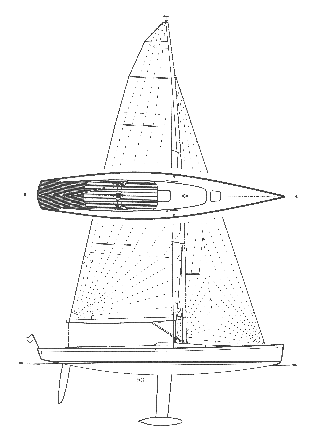Classic 36
Daysailer
To begin with, this boat is 36 feet long and weighs 8,200 pounds. The beam is minimal at 6 feet, 11 inches and draft is optimized at 9 feet. This boat would be right at home in the deep, choppy waters of Puget Sound.
The topsides are slabby, and this is not pretty. But with all the righting moment being provided by a 3,760-pound lead bulb on the bottom of a 970 pound steel fin, this boat does not need stability help from topsides flare, especially since flare on its own just adds resistance and is slow.
The L/B of this design is 5.22 and that's the lowest I have ever calculated. This boat is proportioned like a big Etchells or a meter boat. By the way, we should congratulate Mr. Nelson for his recent second-place finish at the Etchells world championship in San Diego. Heknows how to draw them and drive them.
Karen with its short ends is all sailing length with a D/L of 121. The daggerlike rudder and keel come right out of N/M's work with America's Cup boats. Note how symmetrical the fore-and-aft rocker is on this boat. To my eye the stern is a little on the chunky side, but it's a problem combining the right shape for boat speed with the aesthetics of a traditionally raked transom. If the stern bothers you, just look at the bow. It's deliciously beautiful.
The rig is a carbon fiber mast by Matrix Masts of New Zealand, painted to look like a wooden spar. The boom is a Park Avenue type, which means it is quite wide on top. This allows the lazy jacks to move outboard so that they don't hang up on the headboard when you are raising the main on its 2:1 halyard. The fall of the main halyard is routed to remain below deck. The mainsheet is a 3:1 purchase without a traveler that is led forward under the deck to exit at a pod-mounted winch in the cockpit. This pod also houses the engine controls and the hydraulic headstay adjustment cylinder. Outhaul, vang and reef controls are all up near the gooseneck. The swept spreaders eliminate the need for a backstay and rig depowering will be done with the hydraulic headstay. Pump it up for heavy air and ease it off for light air. The jib is 106-percent LP. The SA/D is 27.54.
There's a head in the cuddy cabin along with seats, but that's it for "accommodations." This is a true daysailer. This design was conceived for transport in a standard 40-foot shipping container so that it could be taken anywhere in the world. The mast breaks down into two pieces.
I have a design under construction at Marten Marine in New Zealand. In fact my youngest son just spent his summer down there with hospitality provided by Steve and Wendy Marten.
Marten Marine is as good a high-tech yard as you can find. I was lucky to get the odd photo or two of Karen along with photos of my own project. I never did get a photo that showed Karen in its entirety though. We only saw a detail or two. But that was enough to tell us that here was a very special yacht being produced by a fastidious work crew.
The hull is a sandwich using kauri wood and e-glass skins with epoxy vacuum bagged over PVC foam. The kauri skins are on the inside giving the interior of Karen a spectacular look. Carbon fiber is used to stiffen the hull and deck in way of the keel, mast and chainplates. Internal stiffening is a molded e-glass/carbon/foam composite. The cockpit features teak decking.
I've got to stop here so I can wipe the drool off my keyboard.

Comments